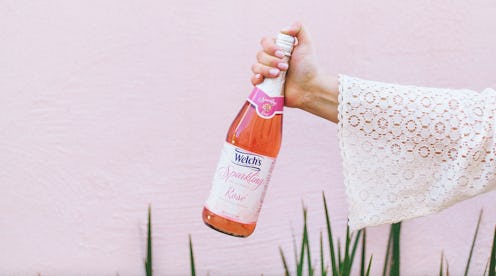Life
Non-Alcoholic Rosé Is Here Just In Time For The Summer & The Bottles Are GORGEOUS

Kind of dig the “rosé all day” lifestyle, but don’t actually drink wine? Good news — that most venerable of grape juice purveyors, Welch’s, has you covered: Welch’s Sparkling Rose is the non-alcoholic rosé of your dreams, containing the delightful bubbles and the cheerful pink hue without any of the booze (or the potential hangovers).
While it’s true that interest in rosé is at a high right now — sales of the pink wine rose a whopping 53 percent by volume in 2017, according to Forbes — the fact of the matter is that about one in three adults in the United States don’t drink. What’s more, although the “rosé all day” philosophy uses the pink drink as a sort of shorthand for embracing the whimsy in life, there’s no denying that it can be somewhat problematic as well (in some respects, it both minimizes and promotes substance abuse). So what’s a person to do if the whimsical nature of pink wine appeals to you, but you’re staying away from alcohol?
Now there’s an answer: Pink sparkling grape juice.
Sparkling juices have long been a part of Welch’s repertoire, but as Matt Smokler, Welch’s Associate Brand Manager, put it in a press release provided to Bustle, “The Welch’s Sparkling franchise is busting out of the holidays. We’re expanding our great sparkling juice tradition into summer with the introduction of Sparkling Rosé, so consumers looking for non-alcoholic offerings can celebrate all year long.” Raising a glass for a celebratory occasion? Sparkling Rosé. Hanging out with friends by the pool all day? Sparkling Rosé. Just, y’know, into bubbly, pink beverages? Sparkling Rosé. According to Smokler, the drink is “crisp” and “balanced,” combining both “the sweetness and tartness of ripe summer fruit”; additionally, Dave McIntyre at the Washington Post described it as having "the right body: and "the right acidity and dryness for rosé." He also called it "tasty and refreshing," which honestly sounds divine to me.
Is it weird that I’m actually kind of super excited about… grape juice? Maybe, although to be fair, a lot of that has to do with the fact that I grew up in Concord, Mass., which is both where Welch’s is headquartered and where the Concord grape used in many of their products was actually developed. In fact, my family almost moved into the house where the grape was developed when I was about 5 years old, although we ultimately ended up in a different spot.
Now referred to as Grapevine Cottage, the house was originally built in the late 17th/early 18th century; when Ephraim Wales Bull moved in during the 19th century, though, the work performed on the property would eventually earn the place its name. After spending a few years working with Vitis labrusca, a grape native to the area which is also known as the fox grape, Bull finally succeeded in creating the Concord grape in 1849. It was a “runaway success” at the Massachusetts Horticultural Society in 1853, as photographer Diane Pappas put it to WNYC in 2010, and initially at least, Bull made a killing off it. Unfortunately, though, plant patent laws didn’t yet exist — and ultimately he died penniless, despite his grape’s overwhelming popularity. He’s buried in Concord’s Sleep Hollow Cemetery, where his gravestone reads, “He sowed, others reaped.” (Ouch.)
Welch’s, meanwhile, was originally founded in New Jersey in 1869 by Thomas Bramwell Welch; his “unfermented wine” (pasteurized grape juice) was intended for use during religious communion services. The company has changed hands a few times in the nearly 150 years since, which also resulted in a few relocations of its home base; in 1982, it finally wound up in Concord, where the grape used to make its signature purple juice is from.
But although Welch’s purple juice uses Concord grapes, the company’s white grape juice is made with Niagara grapes, which hail from Niagara, NY. Welch’s doesn’t specify which kind of grape is used in the Sparkling Rosé, but if I had to guess, I’d go for Niagara over Concord. (I might be wrong, though, so don't quote me on that.) Either way, though, the ingredients list for Welch's Sparkling Rosé is refreshingly short: It consists of grape juice, sparkling filtered water, the preservative sodium benzoate, some citric acid for tartness, “natural flavor,” and another preservative called potassium metabisulfite — that’s it. Oh, and hey, if rosé isn’t your thing, Welch’s also makes a Sparkling Red Grape Juice Cocktail, a Sparkling White Grape Juice Cocktail, a Sparkling Blueberry Grape Cocktail, and Sparkling Cranberry Cocktail. Yum.
Welch’s as a brand is widely available, so you shouldn’t have much trouble finding it; Target, Amazon, Kroger, and Walmart all stock it, for example, which should make locating it a breeze. You can also use the Welch’s store locator to find out exactly which retailers near you carry it, although you might want to ring the store up to find out if they have the Sparkling Rosé in stock before you make the trip.
Cheers!